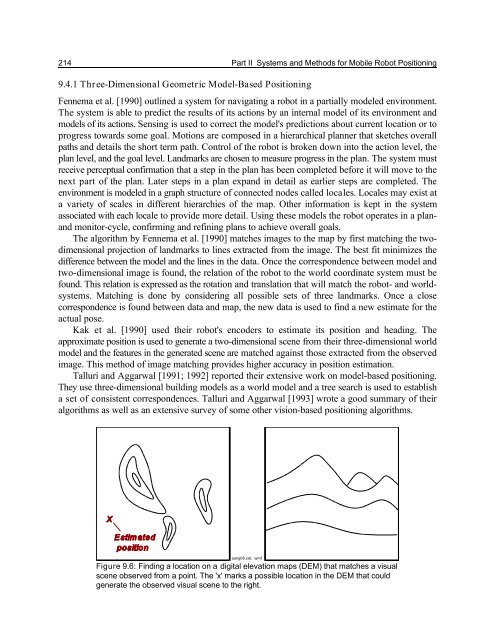Where am I? Sensors and Methods for Mobile Robot Positioning
Where am I? Sensors and Methods for Mobile Robot Positioning
Where am I? Sensors and Methods for Mobile Robot Positioning
Create successful ePaper yourself
Turn your PDF publications into a flip-book with our unique Google optimized e-Paper software.
214 Part II Systems <strong>and</strong> <strong>Methods</strong> <strong>for</strong> <strong>Mobile</strong> <strong>Robot</strong> <strong>Positioning</strong><br />
9.4.1 Three-Dimensional Geometric Model-Based <strong>Positioning</strong><br />
Fennema et al. [1990] outlined a system <strong>for</strong> navigating a robot in a partially modeled environment.<br />
The system is able to predict the results of its actions by an internal model of its environment <strong>and</strong><br />
models of its actions. Sensing is used to correct the model's predictions about current location or to<br />
progress towards some goal. Motions are composed in a hierarchical planner that sketches overall<br />
paths <strong>and</strong> details the short term path. Control of the robot is broken down into the action level, the<br />
plan level, <strong>and</strong> the goal level. L<strong>and</strong>marks are chosen to measure progress in the plan. The system must<br />
receive perceptual confirmation that a step in the plan has been completed be<strong>for</strong>e it will move to the<br />
next part of the plan. Later steps in a plan exp<strong>and</strong> in detail as earlier steps are completed. The<br />
environment is modeled in a graph structure of connected nodes called locales. Locales may exist at<br />
a variety of scales in different hierarchies of the map. Other in<strong>for</strong>mation is kept in the system<br />
associated with each locale to provide more detail. Using these models the robot operates in a plan<strong>and</strong><br />
monitor-cycle, confirming <strong>and</strong> refining plans to achieve overall goals.<br />
The algorithm by Fennema et al. [1990] matches images to the map by first matching the twodimensional<br />
projection of l<strong>and</strong>marks to lines extracted from the image. The best fit minimizes the<br />
difference between the model <strong>and</strong> the lines in the data. Once the correspondence between model <strong>and</strong><br />
two-dimensional image is found, the relation of the robot to the world coordinate system must be<br />
found. This relation is expressed as the rotation <strong>and</strong> translation that will match the robot- <strong>and</strong> worldsystems.<br />
Matching is done by considering all possible sets of three l<strong>and</strong>marks. Once a close<br />
correspondence is found between data <strong>and</strong> map, the new data is used to find a new estimate <strong>for</strong> the<br />
actual pose.<br />
Kak et al. [1990] used their robot's encoders to estimate its position <strong>and</strong> heading. The<br />
approximate position is used to generate a two-dimensional scene from their three-dimensional world<br />
model <strong>and</strong> the features in the generated scene are matched against those extracted from the observed<br />
image. This method of image matching provides higher accuracy in position estimation.<br />
Talluri <strong>and</strong> Aggarwal [1991; 1992] reported their extensive work on model-based positioning.<br />
They use three-dimensional building models as a world model <strong>and</strong> a tree search is used to establish<br />
a set of consistent correspondences. Talluri <strong>and</strong> Aggarwal [1993] wrote a good summary of their<br />
algorithms as well as an extensive survey of some other vision-based positioning algorithms.<br />
sang06.cdr, .wmf<br />
Figure 9.6: Finding a location on a digital elevation maps (DEM) that matches a visual<br />
scene observed from a point. The 'x' marks a possible location in the DEM that could<br />
generate the observed visual scene to the right.

















